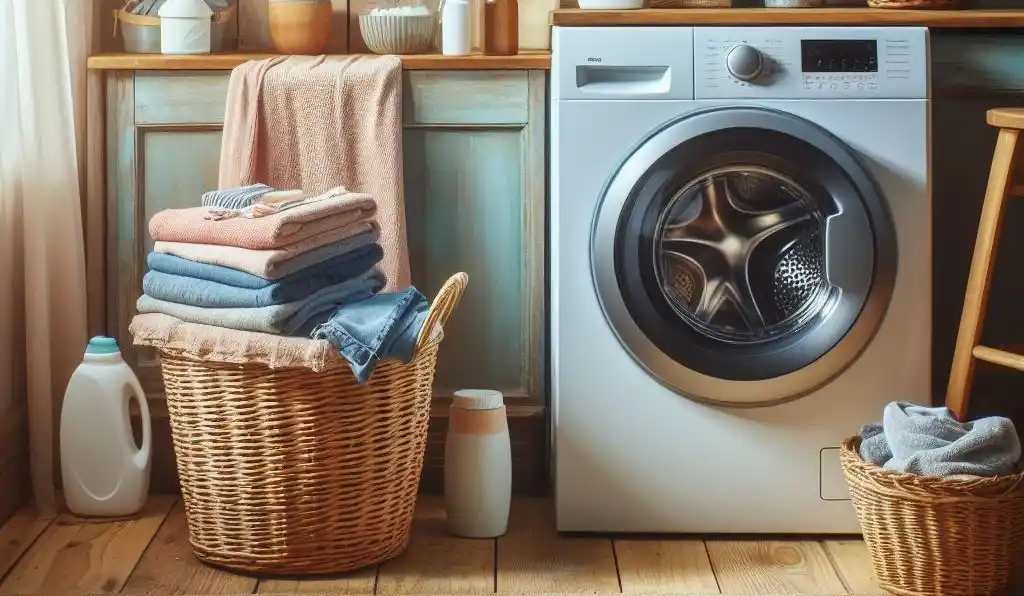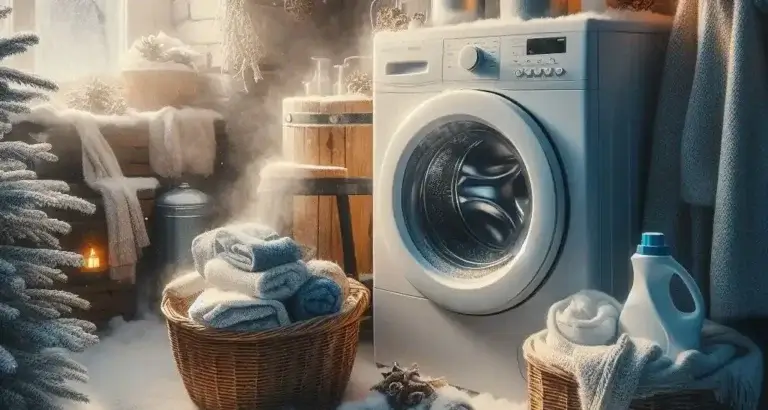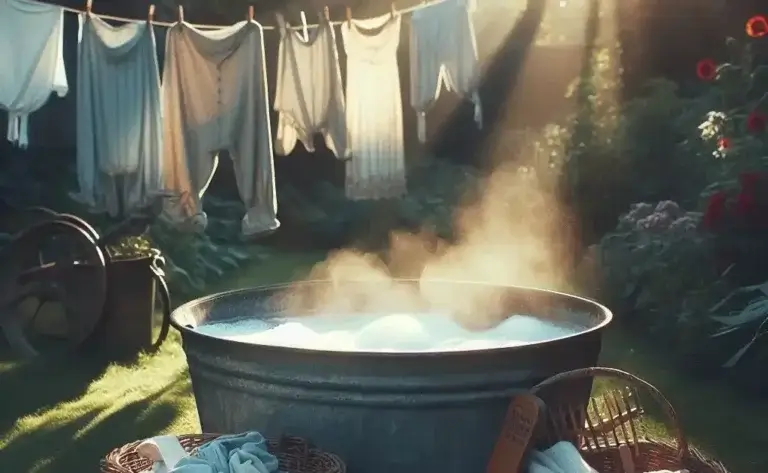Can You Do Laundry in Freezing Weather? Laundry Success When It’s Extreme Cold Weather Outside
Carrying out laundry when it’s cold outside can be challenging, particularly if your poorly insulated machines are in the basement or garage. Frigid temperatures can wreak havoc on appliances like your washing machine and dryer, and no one wants to deal with broken pipes or puddles of water on the laundry room floor.
But don’t let Old Man Winter and his freezing temps keep you from sparkling clean clothes! With some simple precautions, you can safely run the wash even when it’s downright icy outdoors.
In this ultimate guide, we’ll cover whether can you do laundry in freezing weather and everything you need to know to beat the winter laundry woes, including Be sure to start with a warm water cycle when doing your laundry during colder weather to prevent the water intake valve from breaking.
- How cold temperatures affect washing machines and dryers
- The best place to locate appliances when it’s freezing
- Adjusting water lines, hoses, and valves for cold weather
- Running wash cycles becomes more complex and caution-requiring in cold temps to avoid water damage as a result.
- Drying laundry when it’s icy outdoors
- Winterizing your laundry room
- Steps to take for extreme cold snaps and blizzard conditions
- FAQs about doing laundry in frigid weather
Arm yourself with the info below and you can handle any laundry task, no matter the weather outside! Conquer the cold and keep your favorite clothes clean all winter long.
Table of Contents
How Extreme Cold Temperatures Affect Washing Machines During Winter Chillss
When the mercury dips well below freezing, home appliances like washing machines become vulnerable to damage and malfunctions. Here’s how extreme cold impacts these hardworking laundry helpers:
- Water Lines and Valves Can Freeze and Crack – The cold causes water intake valves and supply lines leading to the washer to freeze up. The ice expands, leading the valve or lines to crack and leak water everywhere when they thaw.
- Water Tanks and Tubs Can Crack – In very cold temperatures, any residual water sitting in the washer’s tub or water tank can freeze. This ice expansion puts pressure on the components, leading to cracks once the ice melts.
- Electronics and Control Boards Fail – Extreme cold can cause condensers, sensors, control boards, and other washing machine electronics to malfunction. The components just aren’t made to operate when temperatures plunge below freezing.
- Poor Drainage Leads to Overflow – Freezing temps cause drainage problems too. If the drain line or water pipes freeze or get clogged from ice blockages, water skips its path and you end up with an overflowing soapy mess, excess water all over the laundry room floor.
- Excess Vibration and Noise – The cold, especially in a basement or garage, can make plastic and metal washing machine parts contract, thereby affecting your appliances. All that shrinking leads to loose fittings, strange vibrations, and loud banging noises during the wash cycles.
While most washing machines are designed to handle some cold weather, extended exposure to freezing temperatures tends to take its toll. But with proper precautions, you can safely run laundry even when the thermometer plummets.
Best Places to Locate Washing Machine When Temperatures Drop Below Freezing

Where you situate your washing machine makes a big difference in winter. Some areas of the home provide more insulation and protect appliances from frigid outdoor conditions.
Here are the best spots for your washing machine when the mercury dips below 32°F:
Basement – Since basements are partially underground, the earth helps insulate them from freezing surface temps. Basements also tend to stay warmer in winter.
Interior Rooms – Locate your washer in an interior laundry room or closet, away from any exterior walls. The fewer walls exposed to the cold outdoors, the better.
Insulated Garages – An insulated garage is warmer than an uninsulated one. And garages are often easier to heat than basements. Just make sure the garage temperature doesn’t drop too low.
Heated Spaces – Laundry rooms or mud rooms with space heaters, heated floors, or HVAC vents leading to the room are ideal. Maintaining above-freezing temps is key.
With your washer safely situated in a warm spot, let’s talk about adjusting appliances for sub-zero weather.
Adjusting Hoses, Valves, and Water Lines for Freezing Weather
Even in a warm basement or laundry room, cold temperatures right outside the exterior walls pose risks for water lines and valves leading to your washer. Here are some tips to winterize the connections:
- Wrap any water supply lines and valves in insulation to prevent pipes from freezing. Products like this self-sealing pipe insulation are easy to install.
- Heat tape also prevents freeze-ups by adding supplemental electric heat. Wrap the tape around valves and pipes, securing it tightly.
- Replace any rubber supply hoses leading to your washing machine with braided stainless steel hoses. Stainless steel is more durable in cold than rubber.
- Make sure the hoses are as short as possible. Water pipes and long hoses are more vulnerable to extreme cold as it gives more surface area for the cold to act on, ice and snow can much more easily block these.
- Turn off water supply valves when not actively doing laundry. Eliminate standing water inside pipes and hoses.
- Drain any residual water from the hoses so an overnight freeze doesn’t crack them. Also, drain the washing machine itself when not in use.
Adjusting valves, lines, and hoses for winter helps prevent leaks, bursts, and water damage once temps drop below freezing. Given the winter chills, let’s delve into the laundry process during the colder weather itself, considering steps you can take!
Can You Do Laundry in Freezing Weather

Doing laundry in freezing weather in the USA can be tricky, but it’s possible! Whether it’s the icy grip of Alaskan winters or the crisp chills of Minnesota mornings, here’s what you need to know:
Washing:
- Pre-chill trick: For outdoor washing, fill your washing machine with cold water first. This will minimize the time cold hoses spend exposed to freezing temperatures.
- Boost cleaning power: If using cold water, consider adding a little extra detergent or a booster like baking soda or borax.
- Winter fabrics: Choose wool or wool-blend washes for sensitive items that shouldn’t face freezing temperatures.
Drying:
- Sun-powered drying: Even on chilly days, sunlight can speed up drying. Position your clothesline in a sunny spot to maximize its effectiveness.
- Indoor rack placement: Strategically place your drying rack near heat sources like radiators, vents, or even dehumidifiers for faster drying.
- Fluff and fold trick: When clothes are almost dry, bring them in and fluff them in the dryer for a few minutes. This warms them up and removes any lingering dampness.
Energy-saving hacks:
- Skip the pre-wash: Unless your clothes are super dirty, pre-washing isn’t necessary and uses extra water and energy.
- Full loads only: Run your washer and dryer only when they’re full to maximize efficiency and reduce energy consumption.
- Air dry when possible: Whenever weather permits, take advantage of the free drying power of the sun and wind. It’s eco-friendly and saves on energy bills.
Regional considerations:
- Mountain states: In places like Alaska and Montana, beware of frozen pipes. Disconnect washing machine hoses or winterize your plumbing if temperatures consistently dip below freezing.
- Northeast: Watch out for snow and windchill. If hanging clothes outside, choose sheltered areas to prevent them from getting blown away or soaked.
- Southern states: Although winters are milder, freezing temperatures can still occur. Be prepared with indoor drying options or use laundromats if needed.
Bonus tip: Check your local weather forecast before doing laundry. If a harsh cold snap is coming, consider planning your laundry day accordingly or opting for indoor-only methods.
By incorporating these tips into your routine, you can conquer laundry in freezing weather with ease, efficiency, and even a touch of creativity. Stay warm and toasty, and happy laundering!
Safely Running the Washer in Freezing Cold Weather
Once you have your washer situated in a warm spot and the connections winterized, it’s safe to proceed with laundry even when the great outdoors resembles an icebox. Here are tips for safely running wash loads in your drafty basement or garage during cold seasons:
Give Appliances Time to Warm Up
First, ensure that the washer itself comes up to room temperature before attempting to fill the tub with a load. Here’s why:
- If you add icy clothes straight from the winter elements to a cold washer, the interior metal and plastic parts shrink and contract. This leads to strange noises and vibrations.
- Any residual water in a cold washer drum or tank also stays dangerously cold. This water needs time to warm so that incoming water doesn’t cause cracks or leaks.
- Allowing the machine interior to warm prevents condensation buildup on electrical parts that can short or fail in freezing weather.
So give your washer at least 60-90 minutes to warm up to room temperature before starting a cycle, especially if the appliance sits near exterior walls.
Use Hot Wash and Rinse Cycles
Run the wash and rinse cycles using the highest temperature water possible for the fabric load. Hot water helps thaw any frozen internal parts while also preventing new ice blockages.
However, don’t shock a freezing cold empty washer with hot water right away when experiencing extreme cold temps. Start with a warm wash, and increase to hot water on the second cycle.
Inspect for Ice Buildup
Before starting your washer in frigid weather, inspect key areas for ice blockages that might hinder operation:
- Water Inlet Valves – Examine valves letting water into the machine for any ice. Carefully melt any buildup with a hairdryer on the low setting before running the washer.
- Drain Lines and Water Pipes – Check the drain hose, the outlet on the machine itself, and the ice maker for ice clogs. Use hot water to carefully melt blockages before adding a wash load.
- Detergent and Fabric Softener Dispensers and Managing Excess Water During Winter – In very cold conditions, diluted detergent residue in the dispensers can freeze. Carefully melt any buildup with a hairdryer on low before adding fresh detergent.
Constant vigilance melts problematic ice before it melts into a big, wet laundry disaster!
Leave the Lid Open Between Loads
Here’s another way to prevent freezing issues inside your washing machine:
Crack open the washer lid or door after finishing a load so residual moisture and dampness escape rather than freezing into troublesome ice.
Use a Drying Rack or Run Dryer Cycles
Even in cold weather, it’s unsafe to leave wet clothes sitting in the washer after a cycle finishes. The lingering moisture breeds mold, mildew, and malodors in the machine.
Instead, transfer washed clothes right away either to an indoor drying rack or straight into the clothes dryer on low heat. Never leave laundry sitting wet in the washing machine itself between cycles.
Safely Drying Laundry Indoors When It’s Freezing Outside
Laundry doesn’t stop after the wash! Even when temperatures are below freezing, you still need to safely dry clothes once they’re clean. In bitterly cold weather, line-drying outdoors is NOT an option unless you want to chisel your skivvies off the line with an ice pick.
Here’s how to safely dry laundry without exposing wet clothes to problematic freezing weather:
Use an Indoor Drying Rack
Invest in a sturdy, sizeable drying rack for indoor use. Position the rack near a heat source like a radiator or vent to facilitate air circulation and evaporation.
Indoor drying racks enable you to air-dry laundry without having to operate the clothes dryer as frequently, which can be very energy-saving during colder weather. This saves money and energy in winter.
Run Clothes Dryer in Winter Chills becomes vulnerable to extreme cold if not properly insulated. on Low Heat
If air drying indoors just won’t cut it, use your clothes dryer strategically. Here are some cold-weather dryer tips:
- Clean the lint trap thoroughly so airflow isn’t obstructed
- Run on the lowest heat setting necessary to get clothes dry
- Make sure the outdoor dryer vent has a flapper to keep cold air out
- Don’t overload the drum so clothes dry faster and it doesn’t cause the water intake valve to malfunction.
- Position the dryer out of drafts and away from exterior walls or poor insulation
With good airflow and strategic heat, your dryer gets the job done energy efficiently no matter how cold it gets!
Steps to Winterize Your Laundry Room Appliances and Connections
For maximum cold weather protection, thoroughly winterize both your washing machine AND clothes dryer.
Follow these winterization steps BEFORE extremely cold weather sets in:
For the water intake valve to break, it necessitates the introduction of warm water into the unit. Washing Machine:
- To prevent a complete loss of power and to maintain the water cycle, insulate all water supply lines, valves, and connections.
- Seal drafts and gaps letting in cold around connections with caulk
- Check supply hoses and replace any worn with braided stainless steel
- Drain all hoses; leave valves shut off when not washing
- Consider building “collars” of insulation around the back of the machine as a step you can take to mitigate the effects of the cold.
- Let the machine interior warm fully before running wash cycles
For the Clothes Dryer:
- Clean exhaust ducts so airflow isn’t decreased
- Check the outdoor vent flapper is working right
- Ensure the dryer sits on a level surface away from drafts
- Vacuum lint buildup from ducts, traps, and interior parts
- Insulate any dryer duct sections that run through unheated, poorly insulated spaces to prevent their temperatures from dropping too low.
- Avoid overloading the drum to facilitate airflow
With washers and dryers thoroughly winterized, let’s talk about what to do when the Arctic cold truly crashes the party.
Braving Extreme Cold Snaps, Blizzards, and Winter Storms
Frigid winter weather generally isn’t an issue for laundry duties. But every so often along comes an extreme Arctic blast or raging blizzard. How do you handle laundry when temperatures plunge to dangerous sub-zero levels for prolonged periods and affect your appliances?
Here are tips for extreme cold and winter storm scenarios:
Adjust Appliance Settings for Cold
If your appliance has a “winter” setting, activate this mode so the wash cycles use extra hot water and spin cycles run longer to combat excess moisture.
Also, delay any cycles running overnight to warmer daylight hours if possible.
Run Backup Heating Appliances
If you lose power, quickly set up emergency backup heating using a portable propane or kerosene space heater.
These heating units are invaluable during the cold temps, keeping laundry room temperatures stable until the main power and HVAC system are restored.
(Ensure to adhere to the necessary safety precautions with emergency heating units during colder weather, which includes making sure they are properly ventilated).
Insulate Vulnerable Parts
Protect your appliances from the intense cold temps by covering them, building protective enclosures or adding insulation, especially if they are situated in the less insulated areas like a basement or garage.
- Wrap exterior pipes, fill gaps, and add extra insulation
- Construct “collars” of insulation around the back and sides
- Build wind-blocking protective walls around exterior units
- Use foam covers or insulated blankets specifically made for appliances
This extra insulation keeps units safer in extremely low temperatures.
Address Drainage Issues ASAP
During Arctic snaps or blizzards, carefully monitor how well water drains out of machines, including your ice maker, as ice instead of water could be a sign your pipes are freezing. Any water sitting stagnant WILL freeze into troublesome ice blocks.
Address any slow drainage right away before this happens by:
- Checking sink drains for ice blockages
- Ensuring drain lines aren’t kinked or blocked
- Pouring hot water down drainage paths to maintain flow
- Calling a plumber if you can’t resolve drainage problems
With your emergency plans in action against freezing weather, you’ll be more than capable of facing ice, snow, hail, or any winter weather challenges that may lead to water damage as a result!
FAQs About Doing Laundry When Temperatures Plunge Below Freezing
Still have some cold weather laundry questions? Here are answers to some frequently asked queries:
Is it safe to run my washer if it’s located in a cold basement?
Can we do the laundry in the garage or basement during winter? Yes – IF the basement maintains temperatures at least slightly above freezing. Ideally, keep basement units about 40°F or warmer. Run a space heater if needed.
Can I hang clothes to dry indoors if it’s freezing outside?
Yes! Indoor drying racks work great for winter laundry duty. Position racks close to heat sources so air flows to dry faster. Just keep an eye that indoor humidity doesn’t get too high.
What temperature is dangerously cold for washing machines?
Temperatures at or below 32°F start posing risks for appliances. But some newer models of washers and dryers, even those in a drafty basement or garage, can handle brief temps into the 20s. Avoid exposing any unit to below 20° continuous cold.
Is it OK to wash clothes overnight when freezing?
Only if your laundry room remains safely above freezing all night long. When expecting winter chills, make sure to shut off the water valves too, securing the water cycle. Drain any lingering interior machine water as well.
Can I put wet clothes in the dryer if they were washed in a cold room?
Yes, but run the dryer on low heat first. Steps you can take include avoiding shocking cold wet clothes with a blast of hot air right away in the tub before a cycle. Let them adjust to the rising warmth gradually.
Don’t let icy temps put your laundry schedule on ice! Follow these tips and tricks for frost-free winter washing and drying success.
In Closing – Conquer Old Man Winter and Keep Your Laundry Sparkling
As you can see, regular winter weather generally isn’t cold enough to keep you from running the usual laundry tasks. But when Old Man Winter gets raging with sub-zero cold snaps or howling winter storms, appliances in your basement or garage need a bit of help staying safe from the elements, since they are vulnerable to cold.
Follow this guide to keep washers, dryers, connections, and laundry components protected – no matter what freezing fiascoes come swirling out of the Arctic this winter.
With your laundry appliances and spaces secured and winterized, changing seasons don’t spell changing clean clothes schedules. Bundle up, prepare for the cold temps, and savor the pleasure of having fresh laundry even in the midst of colder weather!








